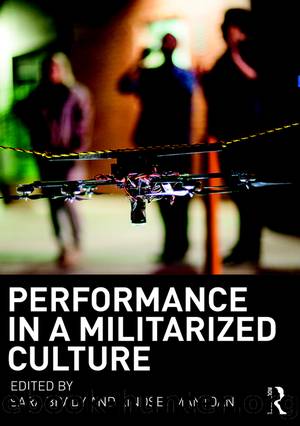Performance in a Militarized Culture by Sara Brady Lindsey Mantoan

Author:Sara Brady,Lindsey Mantoan
Language: eng
Format: epub
Publisher: Taylor & Francis (CAM)
The Raid as Performance
Operation Neptune Spear is most commonly called a raid. Scholars Syed Hussain Shaheed Soherwordi and Shahid Ali Khattak, among others, call it an assassination (2011:349â365). While the response from the US public was varied, including impromptu celebrations at Ground Zero and considered reflection from religious leaders (NPR 2011), most Americans agreed with President Obama that âjustice ha[d] been doneâ (White House 2011). As a performance studies scholar, I view it as, in addition to a covert military operation, a distinctly performative response to 9/11. This performance was staged in complete opposition to the visual and theatrical nature of 9/11; while bin Ladenâs attack on the Twin Towers and Pentagon incinerated mass numbers of people for international television audiences, the US attack on him was a targeted, stealth mission deliberately executed in such a way as to avoid spectacular news media coverage. On 9/11, bin Laden killed thousands; during ONS, the US military killed few. Bin Laden achieved spectacularized violence against the US via mass murder; the US denied him the same spectacularity in death, reportedly taking photos of his dead body but refusing to release them to the public. Regardless of the lack of visual spectacularity associated with killing bin Laden, the raid demonstrated US military prowess and produced iconic representative images through Hollywood. This violence needed bodiesâthe body of a villain and at least one heroâand representations of the raid produced images of both. These copies became more real in the public imaginary than the event itself.
When counterterrorism authorities amassed enough sound intelligence to determine that bin Laden was the man pacing the compound in Abbottabad, Obama and his advisors considered two scenarios for killing him: a B-2 stealth bomber strike and a special forces-led mission (Klaidman 2012:235). Ultimately, Obama opted to send in SEAL Team Six, a decision that some have said stemmed from the presidentâs desire to affirm beyond doubt that bin Laden had been killed (in other words, he wanted a body as proof, not body parts that had been blown to pieces) (20/20 2011). Others said Obama worried that a bomber strike would produce too much collateral damage (Klaidman 2012:241). Secretary of Defense Robert Gates said of Obamaâs decision to send in special forces: âI worked for a lot of these guys and this is one of the most courageous calls [â¦] that I think Iâve ever seen a president makeâ (248). Regardless of the administrationâs party line, the US went out of its way to avoid an act of violence that would bear any visual resemblance to the collapsed buildings and debris bin Laden produced in lower Manhattan. At every step of the process, the principle decision-makers who created and executed Operation Neptune Spear, whether consciously or not, generated an act of violence that looked and felt nothing like 9/11.
In this sense, the raid represented a kind of anti-theatricality, and so did the USâs denial of a trial for bin Laden, which would have no doubt been seeped in spectacle. Like
Download
This site does not store any files on its server. We only index and link to content provided by other sites. Please contact the content providers to delete copyright contents if any and email us, we'll remove relevant links or contents immediately.
Aircraft Design of WWII: A Sketchbook by Lockheed Aircraft Corporation(32189)
The Great Music City by Andrea Baker(31249)
Call Me by Your Name by André Aciman(20349)
The Secret History by Donna Tartt(18805)
The Art of Boudoir Photography: How to Create Stunning Photographs of Women by Christa Meola(18504)
Shoot Sexy by Ryan Armbrust(17637)
Plagued by Fire by Paul Hendrickson(17314)
Portrait Mastery in Black & White: Learn the Signature Style of a Legendary Photographer by Tim Kelly(16933)
Adobe Camera Raw For Digital Photographers Only by Rob Sheppard(16881)
Photographically Speaking: A Deeper Look at Creating Stronger Images (Eva Spring's Library) by David duChemin(16599)
Ready Player One by Cline Ernest(14493)
Pimp by Iceberg Slim(14319)
Bombshells: Glamour Girls of a Lifetime by Sullivan Steve(13952)
The Goal (Off-Campus #4) by Elle Kennedy(13468)
Art Nude Photography Explained: How to Photograph and Understand Great Art Nude Images by Simon Walden(12954)
Kathy Andrews Collection by Kathy Andrews(11708)
The Priory of the Orange Tree by Samantha Shannon(8855)
The remains of the day by Kazuo Ishiguro(8788)
Thirteen Reasons Why by Jay Asher(8767)
